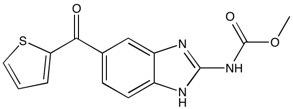Nocodazole | Microtubule inhibitor
NMR (Conforms)

Available Options
| Size : | Price | Quantity | |
|---|---|---|---|
| 10 mg | $50.00 | ||
| 50 mg | $170.00 |
Nocodazole (31430-18-9) is an antimitotic agent that disrupts microtubules by binding to β tubulin and thereby inhibiting microtubule dynamics, disruption of mitotic spindle function, and fragmentation of the Golgi complex.1,2 Arrests cell cycle at G2/M phase. Stimulates the intrinsic GTPase activity of tubulin.3 Nocodazole activates the JNK/SAPK signaling pathway and induces apoptosis in a variety of cell lines.4 Increases Cas9-mediated editing frequencies5 and increased CRISPR-mediated HDR DNA repair6. Cell permeable.
References/Citations:
1) Jordan et al. (1992), Effects of vinblastine, podophyllotoxin and nocodazole on mitotic spindles. Implications for the role of microtubule dynamics in mitosis; J. Cell Science, 102 401
2) Storrie et al. (1998), Dynamics of the interphase mammalian Golgi complex as revealed through drugs producing reversible Golgi disassembly; Biochim. Biophys. Acta, 1404 127
3) Mejillano et al. (1996), Studies on the nocodazole-induced GTPase activity of tubulin; Arch. Biochem. Biophys., 336 130
4) Wang et al. (1998), Microtubule-interfering agents activate c-Jun N-terminal kinase/stress-activated protein kinase through both Ras and apoptosis signal-regulating kinase pathways; J. Biol. Chem., 273 4928
5) Lin et al. (2014), Enhanced homology-directed human genome engineering by controlled timing of CRSIPR/Cas9 delivery; eLife, 3 e04766
6) Li et al. (2023), Modulation of cell cycle increases CRISPR-mediated homology-directed DNA repair; Cell Biosci., 13 215
NMR (Conforms)
Safety Data Sheet:
Product Data Sheet:
Materials provided by Focus Biomolecules are for laboratory research use only and are not intended for human or veterinary applications. Please note that we do not sell to individuals and that all orders placed by non-research organizations will incur a $20 restocking/refund fee
Nocodazole (31430-18-9) is an antimitotic agent that disrupts microtubules by binding to β tubulin and thereby inhibiting microtubule dynamics, disruption of mitotic spindle function, and fragmentation of the Golgi complex.1,2 Arrests cell cycle at G2/M phase. Stimulates the intrinsic GTPase activity of tubulin.3 Nocodazole activates the JNK/SAPK signaling pathway and induces apoptosis in a variety of cell lines.4 Increases Cas9-mediated editing frequencies5 and increased CRISPR-mediated HDR DNA repair6. Cell permeable.
References/Citations:
1) Jordan et al. (1992), Effects of vinblastine, podophyllotoxin and nocodazole on mitotic spindles. Implications for the role of microtubule dynamics in mitosis; J. Cell Science, 102 401
2) Storrie et al. (1998), Dynamics of the interphase mammalian Golgi complex as revealed through drugs producing reversible Golgi disassembly; Biochim. Biophys. Acta, 1404 127
3) Mejillano et al. (1996), Studies on the nocodazole-induced GTPase activity of tubulin; Arch. Biochem. Biophys., 336 130
4) Wang et al. (1998), Microtubule-interfering agents activate c-Jun N-terminal kinase/stress-activated protein kinase through both Ras and apoptosis signal-regulating kinase pathways; J. Biol. Chem., 273 4928
5) Lin et al. (2014), Enhanced homology-directed human genome engineering by controlled timing of CRSIPR/Cas9 delivery; eLife, 3 e04766
6) Li et al. (2023), Modulation of cell cycle increases CRISPR-mediated homology-directed DNA repair; Cell Biosci., 13 215
Calculate the molar concentration, mass or volume in a solution.
Concentration × Volume × Molecular Weight = Mass
Focus Biomolecules • Plymouth Meeting, PA USA • 1-855-FOCUS21
Focus Biomolecules
Plymouth Meeting, PA USA
1-855-FOCUS21
Website Created by Advanta Advertising LLC.

